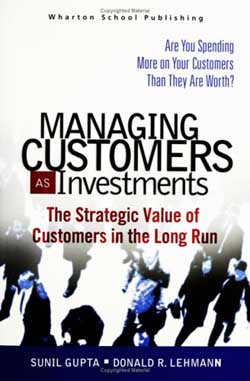Are You Spending More on Your Customers than They are Really Worth? authors Gupta and Lehmann ask.
Based on my experience, Why Should We Care? is the return question. Lots of companies apparently do not care, at least not yet. But someday these companies will “hit the wall” with the traditional focus on acquiring new customers, and then they will care. Just a Case of History Repeating, don’t ya know.
When I published the 3rd edition of my book, I was pretty sure the business world had finally made it past “Why Should We Care?” and would be on to “How Do We Do This?”. Wrong, as Ron constantly remind me. Before the book reviewed below was published, I was using what I called the “portfolio approach to managing customers” idea to set up the Current Value / Potential Value model. Spent an entire chapter on the idea. Apparently, that was not quite enough to answer the “Why Should We Care” question. My bad. Turns out the same idea is worthy of an entire book. Sigh…
So for those of you who are more interested in the “Why Should We Care?” (90% of You?) as opposed to the tactical “How Do We Do This?” presented in the Measuring Engagement Series, I give you the following book:

This is a 6 Chapter, no nonsense, 165 page book that is heavily annotated with the kinds of “proof” you need to potentially get your Boss to care about this topic. I mean, the boss-person can just hit the EndNotes (another 33 pages with the Appendix) and find out how the theories, formulas, and examples in this book have all been well documented by a slew of hard core academics and Consultainers alike. These references to various studies, books, papers, and so on probably have more impact than say, sending an e-mail to the boss titled “Interesting Stuff” with a link to my blog…
The book is easy to read and shoves all the “Math” into the Appendix so whether you’re using the right or left brain you can follow right along – ignore the math and just Grok the pictures, or get right down into full-blown proofs with your Calculus shoes on. Have it your way, as they say.
Just look at these Chapter Titles:
1. Customers are Assets – no argument there from me. Want definitive proof? Here it is.
2. The Value of A Customer – do you know the value of yours? Here is an easy – and I mean easy – way to estimate this value. Call it Lifetime Value “Light” – it’s way better than what you have now, I bet.
3. Customer-Based Strategy – Oh, to develop Strategy and actually do something based on the Value of the Customer, as opposed to whining about how they are “in control”. This is the best chapter in the book. Customers can only take control if you give it to them, you know. And that’s a Strategy problem.
4. Customer-Based Valuation – they’re talking firm valuation here, for the purposes of acquiring companies or selling them. As I said before, Wall Street uses the Current Value / Potential Value Model.
5. Customer-Based Planning – as in building Customer Value right into the Business Plan, so the execution is rock solid.
6. Customer-Based Organization – sure, the tough one. How you make it all work in the org. A bit of the Analytical Culture thing.
The Gupta and Lehmann book is great because it takes what I’ve learned through 20 years of “exposure” (Why You Should Care) and explains it in corporate speak, creating links to stock prices and all kind of other good stuff the CFO would really like to hear about, like projecting future sales, estimating the buyout value of the firm, evaluating acquisitions, and so forth. All from the same kind of customer analysis we just worked through in the Measuring Engagement series. Really. Except they hide all the numbers from you – unless you go looking for them.
Oh, and did I mention this info is all well documented by a slew of hard core academics and Consultainers alike? Seriously though, there are over 120 footnotes that at the very least provide you a library of solid references and case studies on the topic of using customer value data to drive increased profits.
So, if you’re a Marketer trying to create a bridge to Finance, get a copy for your friend over there. If you’re an analyst trying to get a deeper understanding of why customer analysis matters to the business side, get a copy for yourself. If all of a sudden you are in charge of “CRM” or “Customer Experience” or whatever they are calling running a business that doesn’t shred its own customers these days, get this book for the sake of your company. The book really is a great read and might help you make sense of all the disparate and seemingly conflicting marketing and service ideas you read about today.
And while you’re at Amazon, get a guide for the people who will have to turn all this Customer Value Data into Profits for you – mine.